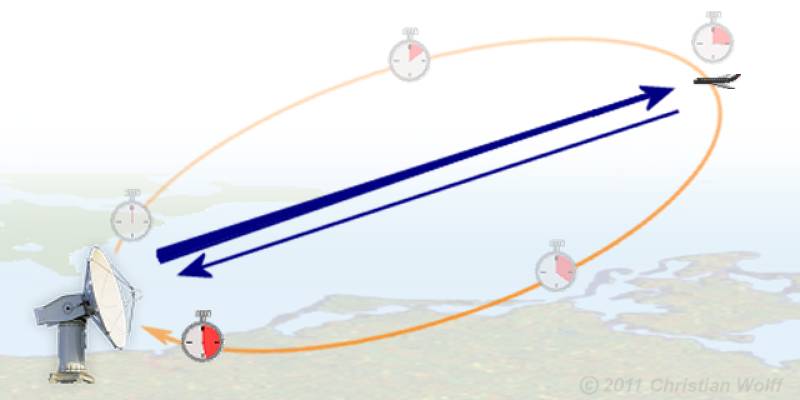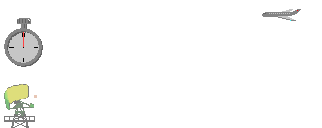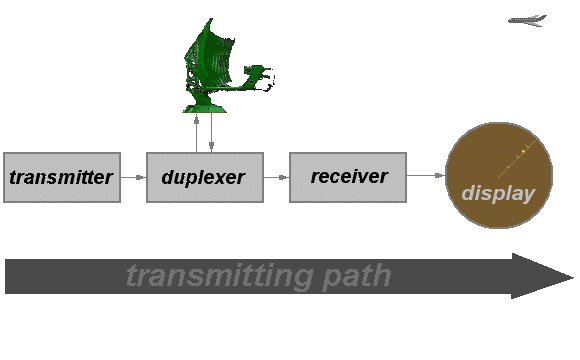Radar Principle
How does Radar work?

Figure 1: radar principle

Figure 1: radar principle
Radar Principle
The electronic principle on which radar operates is very similar to the principle of sound-wave reflection. If you shout in the direction of a sound-reflecting object (like a rocky canyon or cave), you will hear an echo. If you know the speed of sound in air, you can then estimate the distance and general direction of the object. The time required for an echo to return can be roughly converted to distance if the speed of sound is known.
Radar uses electromagnetic energy pulses in much the same way, as shown in Figure 1. The radio-frequency (rf) energy is transmitted to and reflected from the reflecting object. A small portion of the reflected energy returns to the radar set. This returned energy is called an ECHO, just as it is in sound terminology. Radar sets use the echo to determine the direction and distance of the reflecting object.
The term RADAR is an acronym made up of the words:
RAdio (Aim)° (Aim) Detecting And Ranging
The term “RADAR” was officially coined as an acronym by U.S. Navy Lieutenant Commander Samuel M. Tucker and F. R. Furth in November 1940. The acronym was by agreement adopted in 1943 by the Allied powers of World War II and thereafter received general international acceptance. [1]
It refers to electronic equipment that detects the presence of objects by using reflected electromagnetic energy. Under some conditions, radar system can measure the direction, height, distance, course, and speed of these objects. The frequency of electromagnetic energy used for radar is unaffected by darkness and also penetrates fog and clouds. This permits radar systems to determine the position of airplanes, ships, or other obstacles that are invisible to the naked eye because of distance, darkness, or weather.
Modern radar can extract widely more information from a target's echo signal than its range. But the calculating of the range by measuring the delay time is one of its most important functions.
Basic design of radar system
The following figure shows the operating principle of a primary radar set. The radar antenna illuminates the target with a microwave signal, which is then reflected and picked up by a receiving device. The electrical signal picked up by the receiving antenna is called echo or return. The radar signal is generated by a powerful transmitter and received by a highly sensitive receiver.

Figure 2: Block diagram of a primary radar

Figure 2: Block diagram of a primary radar

Figure 2: Block diagram of a primary radar (interactive picture)
All targets produce a diffuse reflection i.e. it is reflected in a wide number of directions. The reflected signal is also-called scattering. Backscatter is the term given to reflections in the opposite direction to the incident rays.
Radar signals can be displayed on the traditional plan position indicator (PPI) or other more advanced radar display systems. A PPI has a rotating vector with the radar at the origin, which indicates the pointing direction of the antenna and hence the bearing of targets.
- Transmitter
The radar transmitter produces the short duration high-power rf pulses of energy that are into space by the antenna. - Duplexer
The duplexer alternately switches the antenna between the transmitter and receiver so that only one antenna need be used. This switching is necessary because the high-power pulses of the transmitter would destroy the receiver if energy were allowed to enter the receiver. - Receiver
The receivers amplify and demodulate the received RF-signals. The receiver provides video signals on the output. - Radar Antenna
The Antenna transfers the transmitter energy to signals in space with the required distribution and efficiency. This process is applied in an identical way on reception. - Indicator
The indicator should present to the observer a continuous, easily understandable, graphic picture of the relative position of radar targets.
The radar screen (in this case a PPI-scope) displays the produced from the echo signals bright blibs. The longer the pulses were delayed by the runtime, the further away from the center of this radar scope they are displayed. The direction of the deflection on this screen is that in which the antenna is currently pointing.
)* The word “Aim” was inserted approximately during the time of World War II.
Later, it was left out since RADAR doesn't concern only aims.
